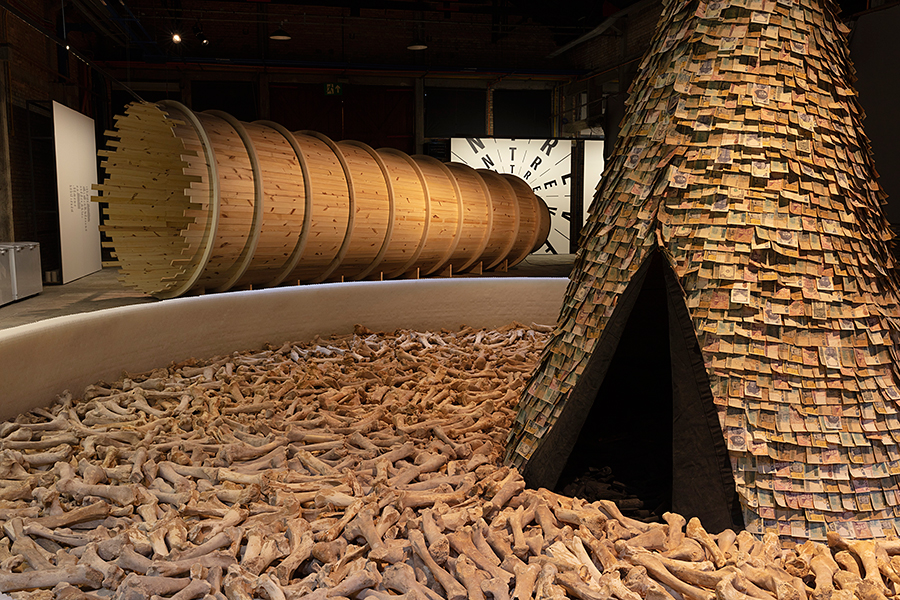‘Poet, Prankster, Activist’: Why Cildo Meireles Has Never Been More Relevant
At Sesc Pompeia, São Paulo, five decades of the artist’s immersive work speak to the brutality and sensuality of American life
At Sesc Pompeia, São Paulo, five decades of the artist’s immersive work speak to the brutality and sensuality of American life

In 1976, Cildo Meireles commissioned a fisherman in the northeast of Brazil to weave a bundle of cotton threads into a net that could hold no fish. Meshes of Freedom (1976/2008), one of the artist’s most important works, began with a repetitive notebook doodle whose form grew like a fractal, which he then produced in different materials, such thread, metal and plastic rods. In ‘Entrevendo’ (Glimpsing), an expansive survey of Meireles’s work at Sesc Pompeia – a former factory converted into an iconic cultural and recreation centre by modernist architect Lina Bo Bardi – each iteration of this permeable structure seems to echo the venue’s design concept: an assembly of open spaces bisected by a channel of water where unlikely groups of people, from sunbathers and chess players to contemporary artists, come together.

Mindful of their diverse audience and the peculiar marriage of modernist refinement and banal function in Bo Bardi’s plan, curators Julia Rebouças and Diego Matos have distributed five decades’ worth of Meireles’s multi-layered work – approximately 150 drawings, photographs, sculptures and installations – across eleven thematic sections that can be viewed in any order. You might begin your stroll through the show with the titular Entrevendo (1970/1994): to enter its wooden tunnel, you must first taste two different ice cubes, one sweet and the other salty, and then walk through the dark towards a gust of warm air. The installation, produced decades before ‘relational aesthetics’ became a byword of contemporary art, heightens bodily perceptions of senses other than sight.
The synesthetic experience of Entrevendo is less amusing when cut by the nauseating odour of dried ox bones in Olvido (Forgetting, 1987–89), a structure of 70,000 candles and 3 tonnes of bones encircling a tipi tent made of paper currency of various American countries. Inside the tent, Meireles has placed a pile of coal; the sound of an electric saw plays from a hidden speaker. The installation is one of several works by Meireles that addresses the horrific legacy of colonialism, such as Mission/Missions (How to Build Cathedrals) (1987/2019) and Amerikkka (1991/2013), which are shown here together for the first time.

Meireles’s father was an indigenist, and as a child the artist accompanied him on expeditions to remote indigenous communities throughout Brazil. If some of his symbolic references to colonial exploitation, genocide and resource extraction seem too blunt, they are tragically timely in light of Brazil’s current far-right government and its public incitements of violence against the country’s indigenous population.
Although the sensorial and narrative aspects of Meireles’s installations connect with a broader public, some of the works on view seem intended for a more specialized audience. In his series ‘Physical Art’ and ‘Geographical Mutations’ (both 1969), sharp, typewritten poetic instructions suggest approaches to dealing with space and time, or more precisely with Brazil’s history and geography; schematic drawings on graph paper imagine impossible cartographies, such as the points where a rainbow is born or a waterfall ends. This section of the exhibition also compiles smaller works, such as the striking Condesados (Condensations, 1970/1996), wearable rings that scale the principles of Meireles’s ‘Physical Art’ to the human body. Condensado III (Bombring), for instance, is a cylinder containing gunpowder and lenses, which if exposed to direct sunlight will explode.

Poet, prankster and activist: all facets of Meireles’s sly and deeply critical practice are on display in this exhibition. He has said that as his Meshes of Freedom are woven, the work ‘gains an open and expandable form’. Like the fisherman’s impossible net – one that grows outwards instead of enclosing – Meireles’s immersive installations invite viewers in regardless of their experience or knowledge of contemporary art. Like the architecture with which they are entangled, they are open to democratic possibility.
Cildo Meireles, ‘Entrevendo’ (Glimpsing) continues at Sesc Pompeia, São Paulo, Brazil, through 2 February 2020.























